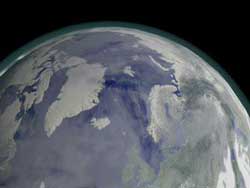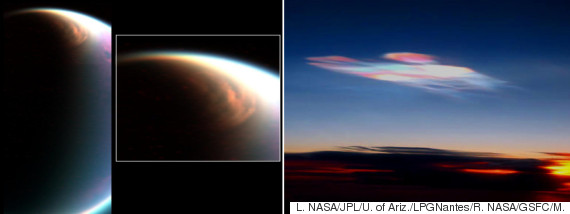
 |
|
Titan's
Atmosphere Revealed by
New NASA Observation Article Courtesy of NASA May 13, 2005 Image above: Cassini's view
of Titan Click
link for more information on these images
Click
here for high resolution copy of image.
Credit: NASA
Titan's
atmospheric winds, temperature and mixing have
been revealed by new observations from the
Cassini spacecraft. The thick atmosphere of
Saturn's giant moon is rich in organic
compounds, whose chemistry may be similar to
that which occurred on Earth before the
emergence of life.
-end-Titan is not just a dot in the sky; these new observations show that Titan is a rich, complex world much like the Earth in some ways," said Dr. Michael Flasar of NASA's Goddard Space Flight Center, Greenbelt, Md., Composite Infrared Spectrometer instrument (CIRS) principal investigator. Flasar is lead author of a paper on this research published May 13 in the Journal Science. The CIRS science team found evidence for an isolated polar vortex similar to one that occurs on Earth. CIRS' observations indicated that strong winds circulating around Titan's north pole isolate the atmosphere there during the polar night. Mixing of the polar region with the lower latitude regions of the atmosphere is inhibited during this time. On Earth, the south polar atmosphere is isolated for months during the long Antarctic winter allowing the formation of polar stratospheric clouds. Normally inert chlorine compounds (such as chlorine nitrate) undergo chemical reactions on the cloud crystals that free molecular chlorine. In the spring, sunlight decomposes the molecular chlorine, leading to the famous annual Antarctic “ozone hole”. Titan's atmosphere contains no ozone; however the CIRS results show that a large part of its atmosphere is isolated during the polar night, and that could allow unusual and complex chemistry to occur. Swirling stratospheric winds around the North and South Pole in winter, called the polar vortex, play a key role in the formation of the Earth's ozone hole.  Image left: Polar Vortex
Animation: Swirling stratospheric winds around
the North and South Pole in winter, called the
polar vortex, play a key role in the formation
of the Earth's ozone hole. The winds confine
cold air and allow polar stratospheric clouds
(PSC) to form. Scientists have concluded that
strong winds also swirl about Titan’s winter
poles and believe there is a similar isolation
of polar air on that body. Click image to see
animation Credit: NASA Image left: Polar Vortex
Animation: Swirling stratospheric winds around
the North and South Pole in winter, called the
polar vortex, play a key role in the formation
of the Earth's ozone hole. The winds confine
cold air and allow polar stratospheric clouds
(PSC) to form. Scientists have concluded that
strong winds also swirl about Titan’s winter
poles and believe there is a similar isolation
of polar air on that body. Click image to see
animation Credit: NASALike Earth, Titan's axis of rotation is tilted, so its poles also experience a long night during winter. The polar winter on Titan is many earth years long, because Saturn orbits the sun once in almost 30 years. Currently it is early winter in Titan's northern hemisphere. The CIRS team found significant temperature differences between Titan's north pole and the equator. The team used this observation to derive the speed of circumpolar winds around the north pole. The team believes these winds are isolating the atmosphere around Titan's north pole because the CIRS data showed that the concentration of several heavy organic (carbon-containing) molecules is highest there. Heavy organic molecules form naturally in Titan's atmosphere, blanketing the moon with an orange haze. Titan’s atmosphere consists of about 98 percent nitrogen with most of the remainder being methane. When these molecules rise to the upper atmosphere, they are broken apart by sunlight and the fragments form heavier organic molecules like propane, ethane, acetylene, hydrogen cyanide, and even more complex molecules. Because the stratospheric air over the winter pole is cold, it sinks and brings down the heavy organic compounds that formed higher up. If the air over Titan's north pole is isolated during the winter, the heavy organics should build up in the stratosphere over the season. This is just what the CIRS team is seeing. "We don't know if there are even more similarities to Earth's ozone hole process, like polar clouds that react with molecules in the atmosphere, simply because we haven't seen them yet," said Flasar. "But we wouldn't be surprised to discover them, nor would we be surprised to find that Titan has some unique twists of its own. This is what makes science so exciting. Nature is too rich for us to predict exactly what we will find when we go exploring." The research was funded by NASA and the European Space Agency. The Cassini-Huygens mission is a cooperative project of NASA, the European Space Agency and the Italian Space Agency. The Jet Propulsion Laboratory, a division of the California Institute of Technology in Pasadena, manages the Cassini-Huygens mission for NASA's Science Mission Directorate, Washington, D.C. Bill Steigerwald Goddard Space Flight Center NASA Press Release 05.13.05 |
|
Polar Winds On Saturn's Moon
Titan Makes It
More Earth-Like Than Previously Thought The Huffington Post By Jacqueline Howard - Posted: 06/21/2015  This natural color composite of Saturn's moon Titan was taken during the Cassini spacecraft's flyby of the moon on April 16, 2005. NASA/JPL/Space Science Institute It turns out that Saturn's moon Titan is way more similar to our own planet than we thought. Scientists previously discovered that Saturn's largest and haziest moon is the only object in the solar system -- aside from Earth -- to have rivers, rainfall and seas. Like Earth, it's bigger than the planet Mercury and has a rocky surface. And now, scientists have found something else that Titan and Earth have in common: Polar wind. In fact, the widespread polar wind is driving gas from Titan's atmosphere out into space. "We need to understand the mechanisms whereby Titan loses its atmosphere. We'd like to understand this better at Titan and at other objects," Dr. Andrew Coates, a physics professor at the University College London in England who led the polar wind research, told The Huffington Post in an email. Coates and his colleagues discovered the escaping gas after analyzing data from NASA's Saturn-orbiting Cassini spacecraft's Plasma Spectrometer (CAPS) instrument, which had detected particles escaping from Titan's atmosphere. Based on the distinctive spectra of particles detected, the researchers concluded that there must be a widespread polar wind on Titan. “Titan’s atmosphere is made up mainly of nitrogen and methane, with 50 percent higher pressure at its surface than on Earth,” Coates said in a written statement. “Data from CAPS proved a few years ago that the top of Titan’s atmosphere is losing about seven tonnes of hydrocarbons and nitriles every day, but didn’t explain why this was happening. Our new study provides evidence for why this is happening.”  This
cloud in the stratosphere over Titan’s north
pole (left) is similar to Earth’s polar
stratospheric clouds (right). NASA scientists found that
Titan’s cloud contains methane ice, which was
not previously thought to form in that part of
the atmosphere. Cassini first spotted the
cloud in 2006.
Rest of story HERE |
Titan
(or Saturn VI) is the largest moon of Saturn. It
is the only natural satellite known to have a
dense atmosphere,[9] and the only object other
than Earth where clear evidence of stable bodies
of surface liquid has been found.
- NASA/JPL/Space Science
Institute
|
Related Links:
|
 Webpages © 2001-2019 Pegasus Research Consortium |